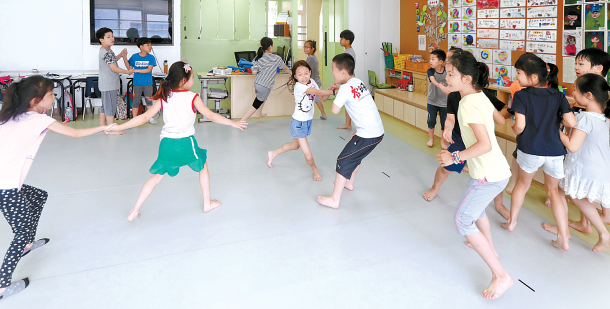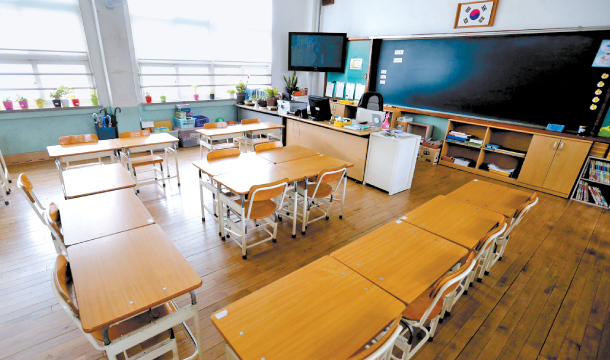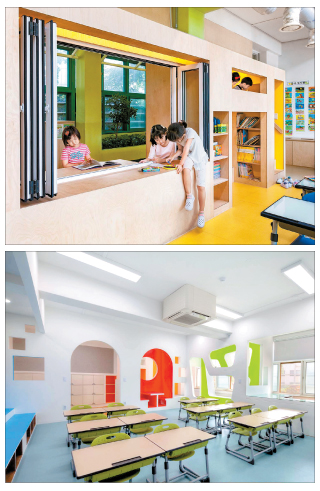Designing classrooms for modern students : Program matches architects with elementary school to design learning spaces for first and second graders

Second graders at Seoul Munsung Elementary School in southern Seoul play inside their new classroom that features soft padding on the floor. The second grade classrooms at the school were remodeled as part of the Seoul Metropolitan Office of Education’s “Dream Classroom” project. [SHIN IN-SEOB]
Seeing her daughter enjoying school so much has really pleased her mother, Lee Ha-yeon.
“Sae-mi is quite sensitive and reserved, so she was just a shy girl in class,” said the mother. “But now she’s very outgoing and active at school. She no longer comes home saying she is tired. She goes to school every morning as if she’s going to a playground, so how can I not be pleased?”
The classroom makeover at Park’s school was a part of the Seoul Metropolitan Office of Education’s “Dream Classroom” project that began last year, and Seoul Munsung Elementary School was selected as one of the schools to be renovated.
Last month, the JoongAng Sunday, an affiliate of the Korea JoongAng Daily, visited Park’s classroom to witness the change. Park and her classmates were lying on the floor, which is no longer cold cement, rolling across the spacious classroom trying to make “human gimbap (seaweed rice rolls),” with their bodies. They were in the middle of a “cooperative play” class, which is an integrated curriculum for elementary schools.

A conventional classroom at an elementary school in central Seoul. [YONHAP]
The most distinctive change from Korea’s conventional classroom, was the layout. Usually a blackboard gets hung up in front of the class and in front of it stands the teacher’s podium, which overlooks rows of student desks. But in Park’s new classroom, the blackboard and the teacher’s podium are positioned against the walls by the corridor, making space in the front and the back of the classroom so that more creative activities can be organized. A small stage is also installed in the back of the classroom. In short, students no longer face “the front” all the time, or even think about where the front of the classroom is.
“One student wrote in their journal, ‘I wish the seven days of the week could be Monday, Tuesday, Wednesday, Thursday, Friday, Friday and Friday so that I can come to school every day of the week,’” said Kim In-won, a teacher who works in the newly-designed classroom. “Thanks to the ‘Dream Classroom’ project, the new space design really changed the attitudes of the students.”

Different architects worked on different schools with the same objective - to design classrooms that are considerate of today’s young students. At top, a new classroom at Seoul Dongdap Elementary School in central Seoul, and above is a classroom at Sangwole Elementary School in northern Seoul. [KIM BUM-JUN]
Shin Ho-seop of SHIN Architects was chosen to design four second grade classrooms at Seoul Munsung Elementary School. Shin says that he was shocked to see the classrooms when he first visited the school.
“[They had] hardly changed from the classrooms of my time,” said Shin. “The curriculum at elementary schools these days has changed a lot from the past. There is more group work and cooperative play for these young students. The new space design caters to these needs.”
Shin says he wanted to design a more spacious classroom and break boundaries.
“I really put a lot of thought into the design so that young students of today can enjoy learning in a better environment,” he added.
Lee Mi-kyung, the school’s principal, said the new classroom design “seems to have even changed the children’s way of thinking [and allows them] to have more freedom.”
“I hope that the classrooms of other grades could also get a makeover,” she added.
Since different architects are assigned to different schools, the remodeled classroom designs differ from one another. Architect Choi Hae-jin of ODDs&ENDs designed classrooms for first graders at Songjeong Elementary School in western Seoul. Choi even designed new multi-purpose furniture for the classrooms that can be either a chair, a cabinet or a stage, depending on the purpose.
According to the architecture firm, the first grade classrooms at Songjeong Elementary School were not only outdated, but “not at all considerate towards students who are the main users.”
“New and innovative curriculums have been adopted but the conventional design of classrooms did not help,” said Choi. “It was necessary to come up with a new design that suits the behavior patterns of students and the new curriculums.”
Empty classrooms at Seoul Geumho Elementary School in eastern Seoul and Sangwole Elementary School in northern Seoul, have been transformed into an indoor playground.
Despite the different designs, every remodeled classroom under the “Dream Classroom” project shares a common goal: catering to children.
“Companies today continue to agonize over better space designs for their employees to increase creativity and collaboration,” said Kim Jung-im of Seoro Architects who directed the “Dream Classroom” project. “In that sense, education institutions have been somewhat neglectful in renewing classroom designs for students.”
According to Kim, only counting first and second grade classrooms, the number of students who have access to the newly designed spaces is already in the thousands in Seoul alone.
“That’s why we are thinking about making the designs and floor plans open source and make it public for other schools to use,” Kim added.
Standard design since 1962
Korea’s education policies have changed numerous times over the years but school designs have stayed the same for more than half a century. This is mainly due to the set standard design for public schools, which was established in 1962. According to the standard, the schoolyard must be located to the south of the school. Each floor should have a long corridor that’s about 10 meters in width, while the floor size of a classroom should be about 9 meters by 7 meters. It even standardizes the size of the windows and the height of a classroom.
This was the country’s attempt to quickly cater to the rapidly increasing number of students in the 1960s, and quickly build many schools at a low cost. The article that states that all schools must follow this standard was removed in 1992, but education offices continued to follow the regulations as a custom. That’s because the standard design, according to experts, seems like the best way to manage and supervise the students while minimizing construction costs.
“The lowest costs per unit area is allocated to elementary, middle and high schools as well as kindergartens among all public buildings,” said Jeon Young-hun, an architecture professor at Chung-Ang University. “It’s even lower than the cost to build a prison. This kind of budget has been blocking the increase in quality of Korea’s education facilities.”
Although slow, changes in classroom designs have been seen ever since Kim Seung-hoy, professor of architecture and architectural engineering at Seoul National University, was appointed as an adviser to the Seoul Metropolitan Office of Education in 2016. It was the education office’s first attempt to improve the learning environment for students and break away from the conventional system.
The attempt was also needed in order to tackle the problem of an increasing number of unused classrooms following the drop in the number of students across the country, as well as aging buildings. According to the education office, 76 percent of the school buildings in Seoul were built in the 1980s, and therefore are in urgent need of repair.
The education office also could no longer neglect the fact that many students are unsatisfied with their school facilities.
“Korean students tend to spend more hours of the day at school than at home,” said Professor Kim. “Therefore, I believe the classroom designs should evolve into a living space that makes our students happy.”
“We should abolish the standardized system of building and managing schools, and really plan and agonize over what kind of design would really be suitable for students today,” Kim added.
In that sense, the “Dream Classroom” project, according to Kim, has been a “positive stimulus for the country’s education circles.”
He appointed Architect Kim Jeong-im to head the project, and encouraged young Korean architects to take part as well.
“This project allowed the architects, parents, teachers and the students to realize how a well-thought-out space design can change so much,” said Kim.
BY HAN EUN-HWA [sharon@joongang.co.kr]
여기, 학교 교실 맞습니다
잿빛 교실, 차가운 시멘트 바닥, 칠판을 향해 놓인 무거운 책걸상…. 지난해 서울 금천구 문성초등학교에 입학한 박세미(8)양의 등굣길이 달갑지 않은 이유들이었다. 세미만 겪는 문제가 아니다. 초등학교 저학년일수록 아이들은 학교 공간에 적응하기 힘들어한다. 이제껏 생활해온 공간과 달리 딱딱하고 획일적인 교실 탓이 크다.
하지만 올해 2학년생이 된 세미는 “방학 오는 게 싫다”며 등굣길을 서두르는 아이가 됐다. 아이의 변화에 가장 기뻐한 이는 어머니 이하연(38)씨다. “세미가 다소 내성적인 성격이라 발표를 소극적으로 했는데 2학년이 되면서 눈에 띄게 활달해졌어요. 발표도 더 적극적으로 하고 학교에서 졸렸다는 소리를 올 들어 아예 안 합니다. 그냥 놀러가듯 학교를 잘 가니 좋을 수밖에 없죠.”
지난달 15일 세미의 교실, 2학년 4반을 방문했다. 두 팀으로 나눠진 18명의 아이는 바닥에 일자로 엎드려 누워 일명 ‘김밥 말기’를 하느라 정신없었다. 친구들 등 위를 구르고 또 구르면서 아이들은 교실 전체를 휩쓸고 다녔다. 통합교과 과정 중 하나인 협동놀이 시간이었다.
푹신한 매트가 깔린 바닥이 이 수업을 가능하게 했다. 아이들은 화사한 연둣빛 교실에서 실내화를 벗은 채 생활하고 있었다. 바닥 난방도 된다. 아이들이 들어 옮길 수 있도록 가볍게 제작된 책걸상은 한쪽으로 치워져 있었다.
가장 독특한 점은 교실의 방향. 교실 앞에 있어야 할 칠판과 선생님 자리가 복도 쪽 벽면으로 옮겨졌다. 아이들은 복도 쪽을 향해 앉아 수업하고, 비워진 교실 앞뒤 공간을 마음껏 쓴다. 교실 뒤편에 계단형 평상을 설치해 무대처럼 쓰게 하면서 그 아래 수납 공간을 마련했다. 지정된 책상에 앉아 앞만 바라보게 했던 교실이 확 바뀐 셈이다. 김임원 담임교사는 “학교 오는 게 좋아서 ‘월화수목금금금’이었으면 좋겠다고 일기를 쓴 친구도 있다”며 “공간이 바뀌자 아이들 태도도 말랑말랑해졌다”며 웃었다.
문성초의 공간 실험은 지난해 처음 실시한 서울시교육청의 ‘꿈을 담은 교실’(꿈담 교실) 공모에 당선되면서 가능했다. 꿈담 교실은 초등학교 1~2학년 교실을 우선으로 리모델링하는 사업이다. 지난해 서울시내 20개 학교의 교실이 바뀌었고, 올해 44개 학교를 대상으로 진행 중이다. 한 명의 건축가가 한 학교를 1대1로 전담하며, 아이들이 19세기 교실이 아닌 21세기 교실에서 생활할 수 있게 바꿔 나가고 있다.
문성초의 2학년 교실 네 반을 디자인한 신호섭 건축가(건축사사무소 신 공동대표)는 “아이들과 함께하는 공간 디자인 워크숍을 위해 학교를 처음 방문했을 때 어릴 적 다니던 교실과 달라진 게 하나도 없어서 깜짝 놀랐다”고 소회했다. 그러면서 “선생님과 아이들과 대화를 많이 해서 놀이 중심으로 바뀐 교육 과정에 맞는 공간을 디자인했다”며 “되도록이면 공간을 비웠고, 교실의 위계를 바꿨으며, 아이들이 더 나은 공간 경험을 어릴 적부터 할 수 있게 신경 썼다”고 덧붙였다. 문성초 이미경 교장은 “공간이 바뀌니 아이들의 사고가 더 자유로워진 것 같다”며 “2학년뿐 아니라 다른 교실도 꿈담 교실처럼 바뀌었으면 좋겠다”고 전했다.
꿈담 교실의 디자인은 학교마다 다르다. 송정초 1학년 교실을 디자인한 최혜진 건축가(오즈앤엔즈 건축사사무소 대표)는 교실에서 쓸 수 있는 다용도 가구를 개발했다. 평소 수납장으로 쓰다가 수업에 따라 의자로, 무대로, 책상으로 변형해 쓸 수 있다.
놀이터야 교실이야~ 유쾌한 변신
금호초 1학년 교실과 상월초 1~2학년 교실은 학생 수가 줄어들면서 생긴 교실 내 여유공간에 다락이나 놀이 공간을 만들었다. 아이들이 작게 쪼개진 공간을 오가며 속닥속닥 놀면서 공부할 수 있다. 디자인은 제각각이지만 사용자인 아이들부터 먼저 생각했다는 게 공통적이다. 아이들의 눈높이에 맞춘 교실이다. 프로젝트의 총괄을 맡은 김정임 건축가(서로아키텍츠 대표)는 “기업 사무실만 해도 창의성을 높이고 더 잘 협업할 수 있는 디자인을 고민하는데 그간 교육 공간을 너무 방치했다”며 “1~2학년 교실만 따져도 서울시내 학급수가 수천 개에 달하다 보니 꿈담 교실의 디자인과 도면 등을 오픈 소스로 공개해 필요한 학교가 사용할 수 있게 하는 방법도 고민하고 있다”고 전했다.
1962년 학교 표준설계도를 아직까지
교육 정책은 숱하게 바뀌었지만 학교 공간은 반세기 넘도록 그대로였다. 1962년 제정된 학교 표준설계도의 영향이 컸다.
운동장은 남쪽에, 학교 동은 북쪽에 일자로, 10m 내외의 폭을 가진 건물에는 꼭 편복도가 있다. 가로·세로 9×7m 교실 너비도, 창문 크기, 천장고도 이 표준설계도에 명시되어 있다. 학생 수에 따라 교실 개수만 정해지면 똑같은 모양의 학교가 뚝딱 지어졌다.
도시 인구가 폭발적으로 늘어나던 때였다. 표준설계도는 기하급수적으로 늘어나는 학생 수를 싸게 수용하기 위한 응급처치와도 같았다. 이를 의무적으로 적용해야 한다는 조항은 92년 폐지됐지만 지금까지 관행으로 남았다. 아이들을 관리·감독하기 좋고, 표준화 덕에 공사비를 줄일 수 있다는 이유에서다. 전영훈 중앙대 건축학부 교수는 “유치원을 비롯한 초·중·고등학교 시설이 공공건축물 중에서도 단위 면적당 공사비가 가장 낮게 책정돼 있다”며 “심지어 교도소보다 싸게 짓는데, 이런 예산편성과 시설기준이 교육공간의 질적 성장을 가로막고 있다”고 덧붙였다.
“집보다 더 오래 머무는 공간에서 행복해야”
2016년 서울시교육청이 2년 임기의 서울교육공간 및 건축 자문관으로 김승회 서울대 건축학과 교수를 임명하면서 변화가 찾아왔다. 땜질식 공간 개선이 아니라 앞으로 어떤 교육 공간이 필요하고 어떻게 바꿀 것인지 제대로 기획해 보자는 첫 시도였다. 그 배경에는 학생 수가 급격히 줄면서 늘어나는 교내 빈 공간의 문제와 80년대 지어진 건물이 76%에 달하는, 낡은 학교 건물의 리노베이션과 같은 당면 과제가 있었다. 통계청이 학생의 학교생활만족도를 조사한 결과 학교 주변 환경과 학교시설의 만족도가 최하위를 차지한 것도 더 이상 묵과할 수 없는 근거가 됐다.
김 교수는 "집보다 학교에서 더 오래 머무는 아이들이 행복할 수 있도록 학교가 생활 공간으로 진화해야 한다고 생각했다”며 "획일적으로 짓고 관리하는 데 그칠 게 아니라 어떤 학교를 만들지 기획하는 것부터 풀어가야 했다”고 설명했다.
변화가 두드러지게 보이는 꿈담 교실은 교육계에 좋은 자극제가 됐다. 김 교수는 김정임 건축가를 임명하고, 능력 있는 젊은 건축가들의 동참을 독려했다. 김 교수는 "건축가와 학생, 교사, 학부모 등 모두가 학교 교실이 이렇게 달라질 수 있다는 것을 알게 된 계기가 됐다”고 전했다.
이미 해외에서는 더 나은 학교 공간을 만들기 위한 다채로운 실험이 한창이다. 미국 텍사스주 트래비스 하이츠 초등학교는 학교와 주변 공원을 연계해 아예 하나의 커다란 공원으로 가꾸고 있다. 도시에 부족한 녹지 공간을 해결하기 위해서다.
지역 커뮤니티를 위해 학교 공간을 활용하는 사례도 많은데 일본 후쿠오카의 하카타 초등학교는 열린 마을 학교를 지향하며, 지역 주민과 함께 쓸 수 있는, 안이 훤히 들여다보이는 강당을 도로변에 두기도 했다.
감옥처럼 폐쇄된 학교가 아니라 미래 인재를 키우기 위한 교육 공간 실험은 이미 세계적인 트렌드다. 우리 교실부터 바뀌어야 한다.
한은화 기자










with the Korea JoongAng Daily
To write comments, please log in to one of the accounts.
Standards Board Policy (0/250자)